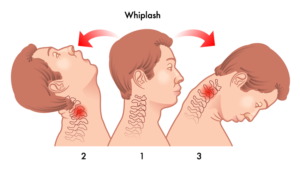Auto Accidents
If you have been riding or driving in a car during your life, the odds are that you have been in an automobile accident. During a survey, it was found that more than 25 percent of drivers were involved in a car wreck in a five-year period. In 2008, there were 10.2 million auto accidents in the United States, injuring 2.4 million people. In fact, someone is injured by a car crash every 14 seconds, which is the leading cause of acquired disability nationwide. One of the most common injuries in an automobile accident is whiplash. Let’s learn more about whiplash and what chiropractic can due to help.
Whiplash
Whiplash is an extremely rapid extension and flexion of the neck that results in injuries to the vertebrae, nerves, discs, muscles, ligaments, and tendons.
There are four phases of whiplash injury. During a rear-end car crash, your body goes through a rapid acceleration and deceleration. In fact, going through the four phases of whiplash takes less than a second. Often, it takes approximately 1/10 of a second.
During the first phase, your car is pushed out from under you and your back is flattened against the seat. This force shoves your cervical spine upwards and compresses your discs and joints. Additionally, your head moves backwards, creating stress. Your headrest, if positioned appropriately, should help reduce the movement of your neck, but damage can still occur.
In phase two, your torso is accelerating faster than your vehicle but your head is still going backwards. This creates an S-curve in your cervical spine. During this same time, your seat is now recoiling forward, acting like a springboard, causing your torso to move forward even more rapidly.
During the third phase, your torso comes to rest again in your seat, but your head and neck are accelerating forward, creating an S-curve in the opposite direction. During the fourth and final phase of whiplash, your torso is stopped by the seat belt and your head continues to move forward with nothing to stop it. This results in a violent forward bending motion of your neck. This force can result in muscle strains and tears, in vertebrae being shoved out of their normal position, in the spinal cord being stretched and irritated, and even the brain hitting the inside of your skull.
We typically use x-ray to detect if the patient has had a whiplash injury. We also take Flexion/Extension x-rays to determine if the patient has had ligament injuries to the Anterior Longitudinal Ligament or the Posterior Longitudinal Ligament. We also refer for other imaging devices, such as a CAT Scan, MRI, and Ultrasound, which can show soft tissue injury, so it is essential if you’ve been in an accident to seek treatment with someone who can provide these diagnostic tests.
Common Whiplash Symptoms
- Neck pain and/or stiffness
- Blurred vision
- Difficulty swallowing
- Irritability
- Fatigue
- Dizziness
- Pain between the shoulder blades
- Pain in the arms or legs, feet, and hands
- Headache
- Low back pain and/or stiffness
- Shoulder pain
- Nausea
- Ringing in the ears
- Vertigo
- Numbness and tingling
- Pain in the jaw or face
We deal with auto accident patients every day, many of whom have experienced whiplash. If you have been injured in a car wreck or other Personal Injury, contact us to find out how we can help.

